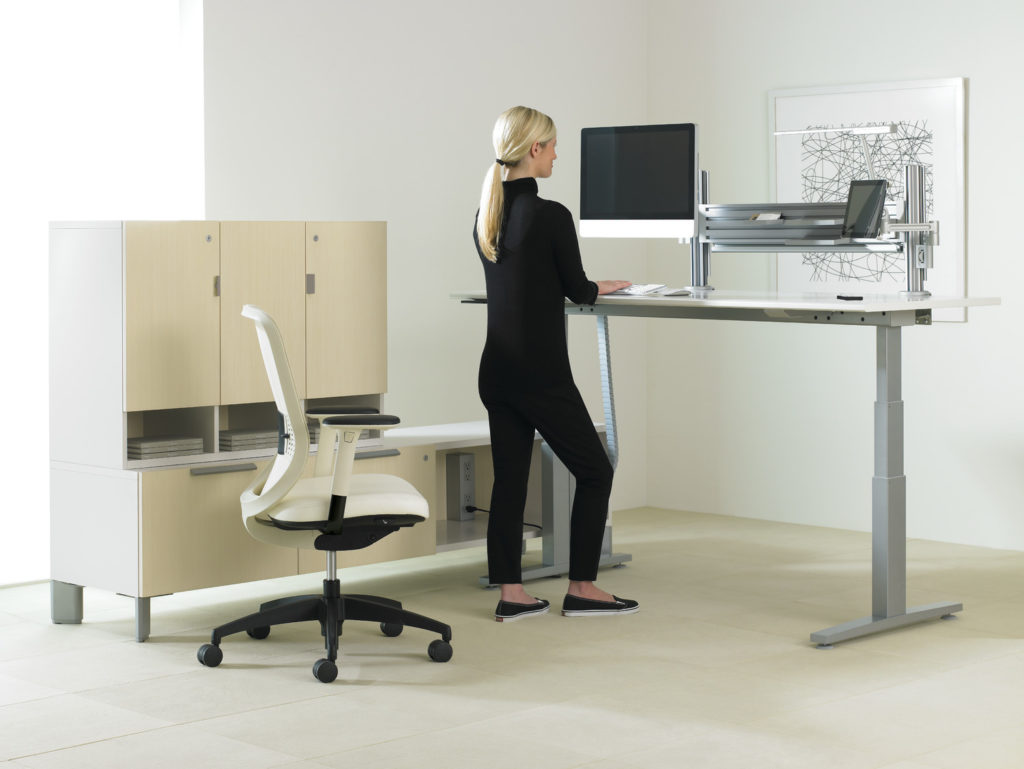
How to Privilege the Ergonomics of a Workstation?
Alarming figures
- People who spend most of their day sitting are 54% more likely to die from a heart attack
- A sedentary lifestyle can increase the risk of cancer by 66%
- Musculoskeletal disorders are the most common cause of disability among workers under 40
- Workers can spend more than 38 minutes per hour skewed
Ergonomics is not a trend. Although it is a very popular concept in the workplace, the figures are scary and hard to ignore. By focusing on the ergonomics in a workplace, organizations improve the well-being of their staff, and exponentially reduce the costs of absenteeism and non-performance.
A range of options help to improve and move towards an ergonomically optimal work environment.
Although often the budget aspect of a project is crucial in the choice of furniture, we hope with simple improvements, stimulate your reflection on the working environment that you offer to your resources, and so, rethink the design and layout of your spaces, always bearing in mind the ergonomic criteria, in order to take full advantage of what your employees have to offer.
The perfect ergonomic workstation
 Wrongly, we think that ergonomic solutions are expensive. However, an ergonomics workstation lies mainly in the adoption of a neutral body position, thanks to carefully adapted and chosen furniture, but also thanks to these few solutions accessible to all:
Wrongly, we think that ergonomic solutions are expensive. However, an ergonomics workstation lies mainly in the adoption of a neutral body position, thanks to carefully adapted and chosen furniture, but also thanks to these few solutions accessible to all:
- Position your monitor so that your eyes are at the same level as the top of the screen. In addition, the distance between your eyes and the screen must be at least one arm away.
- Keep your wrists straight, keeping your forearms supported.
- Your mouse must be close to you. Bring it closer to your body if it is too far away.
- If you have an adjustable workstation, the height of your monitor should be adjusted accordingly so that your eyes are always at the same level as the monitor.
- The angle of your elbows, hips and knees should be 90 degrees. If your table is too high, there are keyboard racks that you could use to solve this problem.
- Your back should be straight, and shoulder to the lumbar support.
- As for your feet, they must be placed flat against the ground. Do not cross your legs: most people will always cross the same side, and this analgesic posture has an extremely harmful effect on blood circulation.
- If you cannot reach the ground with your feet, use a footrest.
Beyond musculoskeletal disorders
Of course, an ergonomic working environment is not just about these few solutions.
You can also prevent headaches by using the 20-20-20 rule:
Many of us spend a good part of our time in front of a screen: computers, smartphones, video games, television… This can cause a lot of tension in the eyes, as well as visual fatigue. When using screens, it is therefore important to rest your eyes.
Comply with the 20-20-20-20 rule. Every 20 minutes, take a 20-second break and look at something that is 20 feet away.

Sitting down, slowly dying
Just that. The increase in sedentary life is closely linked to progress: sitting work has become more democratic, we spend a large part of our time sitting on public transport or in the car.
FOR PROFESSOR FRANÇOIS CARRÉ, CO-FOUNDER OF THE OBSERVATORY OF SEDENTARY LIFE, “INCREASING SEDENTARY LIFE IS LINKED TO THE MISUSE OF PROGRESS. (…) THE LONGER THE DAILY TIME SPENT IN A SITTING POSITION, THE SHORTER THE LIFE EXPECTANCY. ».
As a result, physical inactivity kills more people than smoking and it is proven: in addition to increasing the risk of cancer by 66%, physical inactivity promotes the development of cardiovascular risk factors such as high blood pressure, diabetes, high cholesterol, obesity, with all the complications that this implies…
So if your work allows it, stand up. There are adjustable tables, which allow you to adopt the standing position according to your desires. If your workspace configuration, or your budget, does not allow you to invest in an adjustable workstation, there are solutions such as Humanscale’s Quickstand ergonomic accessory, which allows you to adopt the sit/stand station without necessarily changing your desk.
Here are also some ultimate solutions that won’t cost you a penny: get up to take a call, and take the opportunity to walk. Do you have a question for your colleague? Go meet him in person. Don’t send him yet another email. Your health will return it to you.

Of course, these few tips are only a small part of the solutions available to you. It is obviously preferable to acquire adapted furniture from the beginning of your project, which will avoid many problems. At Groupe Focus, our experienced team will be able to carry out an in-depth analysis, and thanks to its in-depth understanding of the workplace, will guide you towards options that will meet your expectations and budget, without compromising your health or that of the people who commute to work every day.
